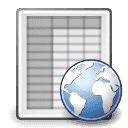User Docs
GPlates

|
GPlates User ManualThe official GPlates user-manual is written by GPlates users in the EarthByte Project, in close collaboration with the GPlates software development team. Read the user manual to learn about GPlates' many functions. The manual describes all of the canvas tools, menus, and dialogs that are present in GPlates and how they can be used. |

|
GPlates TutorialsThere are many Introductory Tutorials viewable online via Google Docs or downloadable as PDF. Each one describes how to accomplish a specific task in GPlates. Read these for a more in-depth guide that explains how various GPlates functions can be used within the context of an example workflow. A video showcasing some of the most recently added functionality of GPlates can be found on the Features page. The live versions of the tutorials are hosted on Google servers. If you are in China or cannot access Google servers, the tutorial PDFs and related files may be downloaded from the archive found here. |

|
GPlates Data ManualRead the Data Manual if you wish to understand how the GPlates model works and how GPlates stores data in its native file format (GPML). This manual may be of particular use to people who want to know how to structure their data so that it can be imported into GPlates easily. There is also a complete technical reference of the GPlates Geological Information Model (GPGIM) for use by advanced users. |
pyGPlates

|
pyGPlates DocumentationPyGPlates is a Python library enabling access to GPlates functionality. This may be of particular use to researchers requiring more flexibility than is provided by the GPlates user interface. Read the PyGPlates documentation if you wish to write Python source code that uses pyGPlates. The documentation includes an installation guide, sample code for common plate tectonic problems and a library reference. |

|
pyGPlates TutorialsThere are PyGPlates tutorials in the form of Jupyter Notebooks that analyse and visualise real-world data using pyGPlates. These tutorials complement the sample code in the pyGPlates documentation by providing a more research-oriented focus. |
GPlately

|
GPlately User ManualGPlately was created to accelerate spatio-temporal data analysis leveraging pyGPlates and PlateTectonicTools within a simplified Python interface. The user manual contains rich documentation on all Python functions and objects within GPlately. |

|
GPlately TutorialsGPlately tutorials are in the form of Jupyter Notebooks which document common workflows to reconstruct data, interrogate and compare different plate models, and plotting data on maps. The Jupyter Notebooks are rendered in HTML for quick reference, alternatively download the GPlately GitHub repository to run the notebooks on your own computer. |
GPML
Click here to find out more about the GPlates Markup Language(GPML), the “native” file format of GPlates.
Compiling GPlates
Instructions on how to compile GPlates from source may be found in the GPlates source-code releases, in the files:
- DEPS.Linux and BUILD.Linux (on Linux)
- DEPS.OSX and BUILD.OSX (on macOS)
- DEPS.Windows and BUILD.Windows (on Windows)